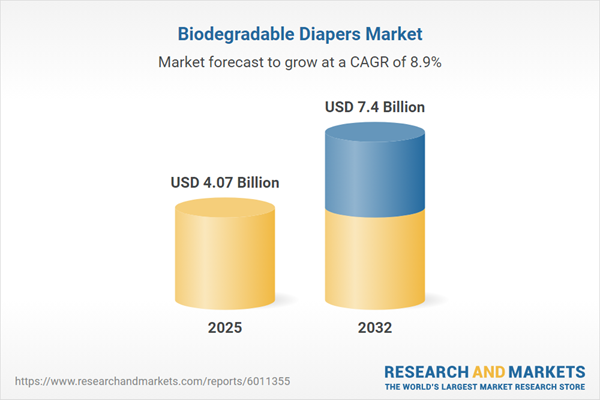Speak directly to the analyst to clarify any post sales queries you may have.
The biodegradable diapers market is undergoing a transformation as sustainability, innovation, and consumer preferences reshape the infant care landscape. Industry leaders are responding to demand for eco-friendly, high-performing, and convenient solutions, advancing new products designed to deliver environmental impact without compromising usability.
Market Snapshot: Growth and Performance of the Biodegradable Diapers Market
The biodegradable diapers market grew from USD 3.74 billion in 2024 to USD 4.07 billion in 2025. It is expected to continue growing at a CAGR of 8.91%, reaching USD 7.40 billion by 2032. This expansion reflects rising regulatory attention, increasing consumer demand for sustainable alternatives, and steady innovation in renewable materials and design. The primary keyword biodegradable diapers market appears as an essential topic and focus area for brands aiming to secure a competitive position.
Scope & Segmentation
- Sales Channels: Offline (drugstores & pharmacies, specialty stores, supermarkets & hypermarkets) and online (brand website, third-party marketplace) channels are analyzed for their differing impacts on consumer engagement and product visibility.
- Material Types: Bamboo, cornstarch, and recycled pulp are included to address a diversity of consumer priorities from renewability to compostability and cost efficiency.
- Age Groups: Infant, newborn, and toddler segments reflect differentiated needs in terms of skin sensitivity and absorbency.
- Product Types: Compostable (home compostable, industrial compostable) and flushable formats address disposal challenges and expand market accessibility.
- Regional Coverage: Americas (United States, Canada, Mexico, Brazil, Argentina, Chile, Colombia, Peru), Europe, Middle East & Africa (UK, Germany, France, Russia, Italy, Spain, Netherlands, Sweden, Poland, Switzerland, UAE, Saudi Arabia, Qatar, Turkey, Israel, South Africa, Nigeria, Egypt, Kenya), and Asia-Pacific (China, India, Japan, Australia, South Korea, Indonesia, Thailand, Malaysia, Singapore, Taiwan).
- Leading Companies: The Honest Company, Abena A/S, Dyper Products, Nature Babycare, Cascades Tissue Group, Hain Celestial Group, Seventh Generation, and Eco Pea Co.
Key Takeaways for Senior Decision Makers
- Sustainability is now integral to product design as both regulatory scrutiny and end-user demand place biodegradable attributes at the forefront.
- Manufacturers are increasingly sourcing renewable materials such as bamboo and corn starch, alongside recycled pulp, to differentiate offerings and ensure material security.
- Digital and direct-to-consumer channels allow brands to communicate value propositions, lifecycle transparency, and customizable purchase models more effectively to target demographics.
- Product innovation is accelerating through partnerships with biopolymer innovators and investments in advance manufacturing processes.
- Channel segmentation reveals offline retail remains crucial for shopper reassurance, while online ecosystems are rapidly driving adoption.
- Education, supply chain traceability, and regulatory engagement are emerging as levers to build credibility and customer trust.
Tariff Impact: Navigating U.S. Regulatory Shifts
New United States tariffs on imported pulp and compostable polymer additives have pressured firms to reevaluate global supply chains. In response, many have established domestic partnerships and optimized manufacturing processes to mitigate margin impacts. This adjustment has fostered resiliency and catalyzed local investment, with agile brands capitalizing on regulatory change to capture new growth opportunities.
Methodology & Data Sources
The report synthesizes executive interviews, supplier surveys, and insights from material scientists and waste management experts. Data triangulation—combining primary interviews, secondary research, and scenario analysis—underpins all conclusions. Quantitative modeling is paired with qualitative frameworks to ensure perspectives from across the industry converge for robust and actionable insights.
Why This Report Matters
- Gain a multidimensional understanding of consumer needs and innovation catalysts in the biodegradable diapers sphere.
- Identify actionable opportunities to navigate regulatory environments and evolving consumer expectations in key global regions.
- Benchmark strategies and product developments against market leaders to support future investments and alliance-building.
Conclusion
Market growth in the biodegradable diapers sector is strongly influenced by regulatory developments, material innovations, and strategic industry partnerships. Senior stakeholders equipped with in-depth analysis can drive sustainable product leadership and capitalize on emerging trends in infant care.
Additional Product Information:
- Purchase of this report includes 1 year online access with quarterly updates.
- This report can be updated on request. Please contact our Customer Experience team using the Ask a Question widget on our website.
Table of Contents
3. Executive Summary
4. Market Overview
7. Cumulative Impact of Artificial Intelligence 2025
List of Figures
Samples

LOADING...
Companies Mentioned
The key companies profiled in this Biodegradable Diapers market report include:- The Honest Company, Inc.
- Abena A/S
- Dyper Products LLC
- Nature Babycare AB
- Cascades Tissue Group Inc.
- Hain Celestial Group, Inc.
- Seventh Generation, Inc.
- Eco Pea Co, LLC
Table Information
| Report Attribute | Details |
|---|---|
| No. of Pages | 180 |
| Published | October 2025 |
| Forecast Period | 2025 - 2032 |
| Estimated Market Value ( USD | $ 4.07 Billion |
| Forecasted Market Value ( USD | $ 7.4 Billion |
| Compound Annual Growth Rate | 8.9% |
| Regions Covered | Global |
| No. of Companies Mentioned | 9 |









